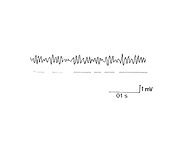
Ocular tremor
Encyclopedia

Human eye
The human eye is an organ which reacts to light for several purposes. As a conscious sense organ, the eye allows vision. Rod and cone cells in the retina allow conscious light perception and vision including color differentiation and the perception of depth...
tremor
Tremor
A tremor is an involuntary, somewhat rhythmic, muscle contraction and relaxation involving to-and-fro movements of one or more body parts. It is the most common of all involuntary movements and can affect the hands, arms, eyes, face, head, vocal folds, trunk, and legs. Most tremors occur in the...
.
It occurs in all normal people even when the eye is apparently still and is due to the constant activity of brainstem oculomotor units. In coma
Coma
In medicine, a coma is a state of unconsciousness, lasting more than 6 hours in which a person cannot be awakened, fails to respond normally to painful stimuli, light or sound, lacks a normal sleep-wake cycle and does not initiate voluntary actions. A person in a state of coma is described as...
there is a loss of high frequency components of tremor and the extent of this reduction is related to the patient's prognosis (2). Ocular microtremor can potentially help in the difficult diagnosis of brainstem death, as well as monitoring patients while under anaesthesia (3). Abnormal OMT records are seen in neurological conditions such as Parkinson's disease
Parkinson's disease
Parkinson's disease is a degenerative disorder of the central nervous system...
and multiple sclerosis
Multiple sclerosis
Multiple sclerosis is an inflammatory disease in which the fatty myelin sheaths around the axons of the brain and spinal cord are damaged, leading to demyelination and scarring as well as a broad spectrum of signs and symptoms...
(4). The frequency spectrum also changes with age.
The first description of what is now known as ocular microtremor was made in 1934 (5). It is contentious whether ocular microtremor assists vision. Visual processes deteriorate rapidly in the absence of retinal image motion, with Stabilized Images
Stabilized images
Stabilized Images are images on the retina that are unaffected by microsaccade or ocular microtremor . Experiments by Riggs and Ratliff ) established the remarkable finding that stabilized images result in the fading and disappearance of the visual percept...
. Journal of Vision
See also
- AfterimageAfterimageAn afterimage or ghost image or image burn-in is an optical illusion that refers to an image continuing to appear in one's vision after the exposure to the original image has ceased...
- human eyeHuman eyeThe human eye is an organ which reacts to light for several purposes. As a conscious sense organ, the eye allows vision. Rod and cone cells in the retina allow conscious light perception and vision including color differentiation and the perception of depth...
- Eye movements
- Fixational eye movement
- Neural adaptationNeural adaptationNeural adaptation or sensory adaptation is a change over time in the responsiveness of the sensory system to a constant stimulus. It is usually experienced as a change in the stimulus. For example, if one rests one's hand on a table, one immediately feels the table's surface on one's skin. Within a...
- Visual perceptionVisual perceptionVisual perception is the ability to interpret information and surroundings from the effects of visible light reaching the eye. The resulting perception is also known as eyesight, sight, or vision...

